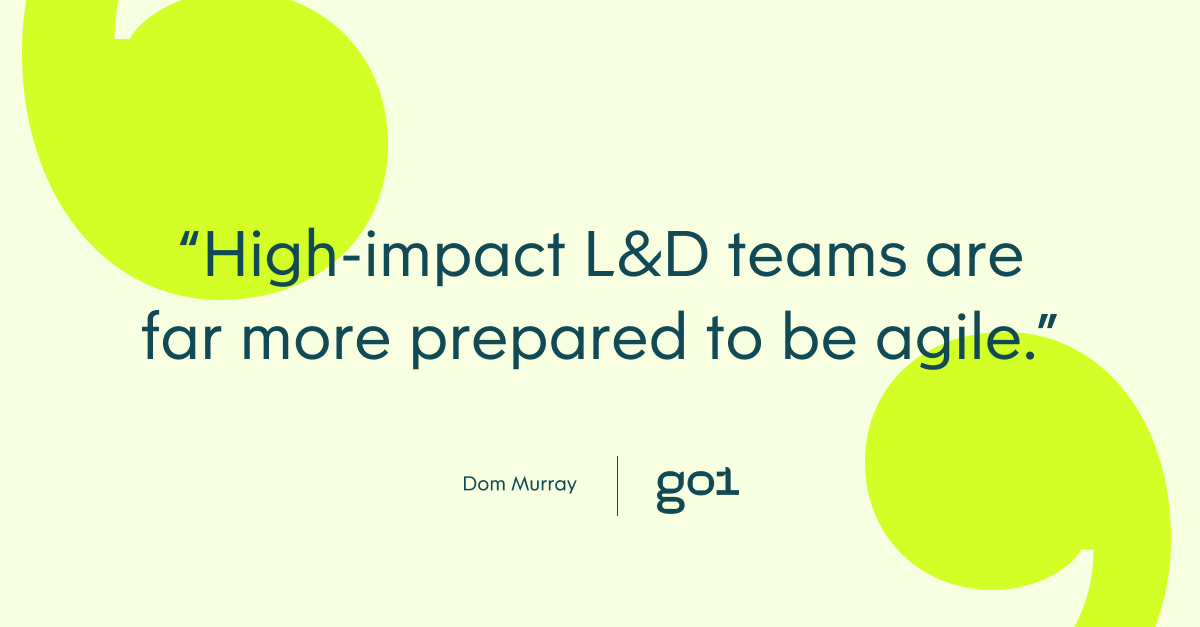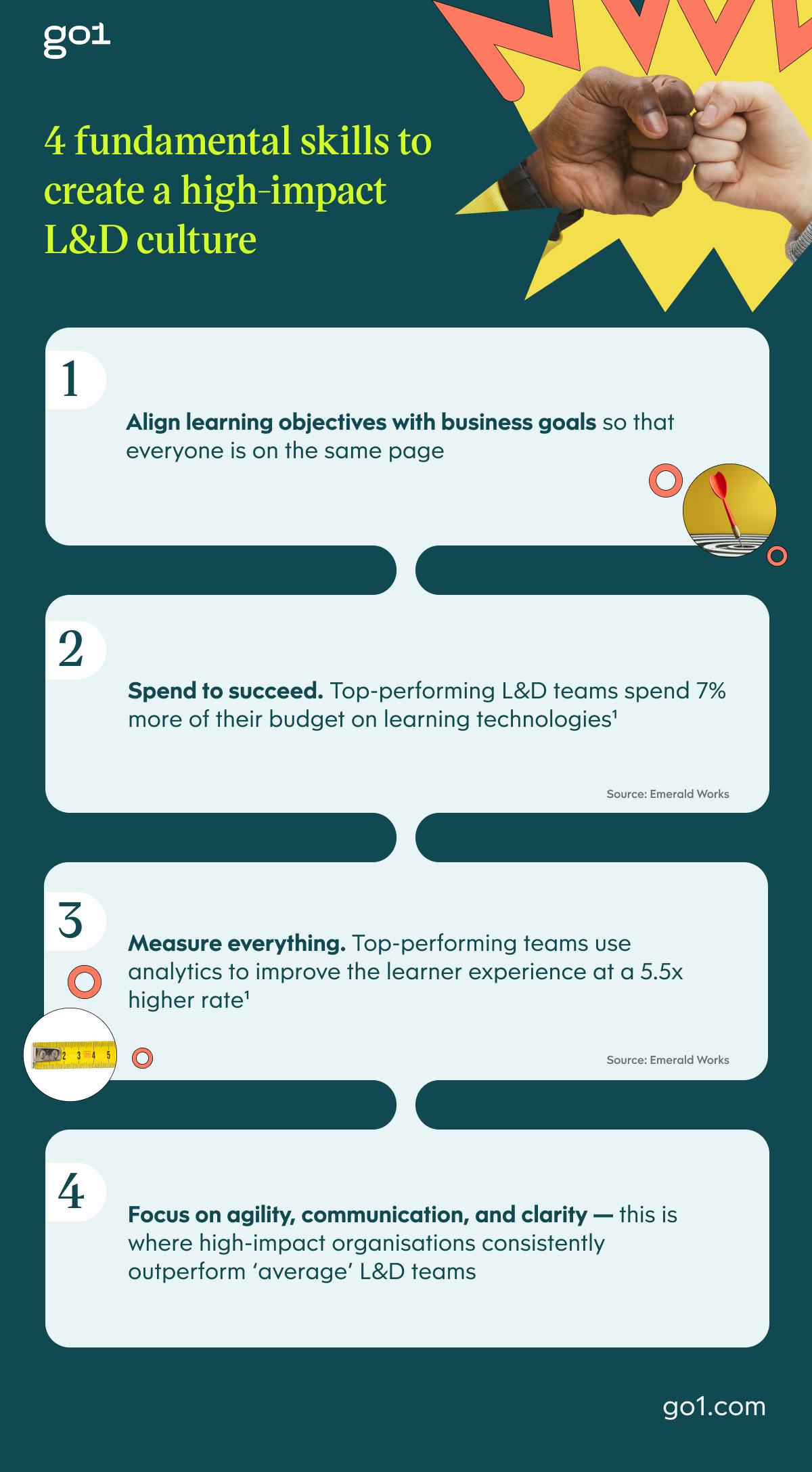
What sets high-impact L&D teams apart?

Every L&D team wants to make an impact. After all, there are few greater joys than watching your learners succeed. However, as with any walk of life, some teams will inevitably be more impactful than others. This success is attributable to many factors, such as organisational alignment, resources, strategy, and adaptability. Whatever the specific reasons, the rest of us strive to catch up and emulate these standard-setting teams.
With this in mind, we have decided to dig a little deeper and ask: what sets high-impact L&D teams apart? We’ll start by detailing common characteristics of high-impact L&D teams, before analysing the skills that set these teams apart.
Ready to boost your team’s impact? Start here.
Common characteristics of high-impact L&D teams
Before we can analyse what sets high-impact L&D teams apart, it is necessary to understand what a high-impact L&D team looks like. Thankfully, when trying to define high-impact L&D teams, a few common characteristics emerge.
Emerald Works 2020 Back to the Future Report closely observed high-impact learning cultures (HILCs). Following a comprehensive survey of 1,123 organisations, Emerald Works identified the top 112 organisations (10%) as having HILCs. According to their criteria, HILCs are “the top performing 10% of our data sample, These organisations’ learning strategies consistently achieve excellent results in terms of organisational growth, transformation, profitability and productivity.”
In a similar survey of 60 CEOs and more than 250 L&D professionals worldwide, MIT Sloan identified seven core principles that set learning organisations apart (more on those to come). More importantly, their research discerned the factors that defined these high-performing teams were a willingness to invest in learning and development with a long-term, strategic perspective while also being prepared to adapt over time.
Finally, in an interview with the Advantage Performance Group, Lucretia Hall from Software One was asked to identify the essential components of a high-performing L&D team. From her perspective, two things stood out. Firstly, she emphasised that every team member must work to their strengths. To achieve this, Ms Hall recommends using the Gallup Strengths Finder to help identify different strengths within your organisation.
Secondly, she added that trust is vital, saying, “the other is building trust. This is the foundation of building a high performing team. It's something that all of our leaders are learning and doing. How do you build trust from the get-go with your team?”
As such, becoming a high-impact L&D team requires consistent excellence, paired with a strategic, long-term vision and clear alignment between both individual team members and discreet business functions.
For more insights on high-impact learning cultures, be sure to read our article on creating a sustainable learning culture.
What sets high-impact L&D teams apart?
According to Emerald Works, high-impact L&D teams stand out from their competitors in several pivotal areas. However, some of the most significant discrepancies emerge in the categories of alignment, communication, and clarity.
For example, 94% of HILCs say their L&D activity is fully aligned with their organisation’s strategic goals. By comparison, only 48% of other L&D teams say the same. This represents a massive discrepancy, revealing that more than half of ‘average’ L&D teams are either not supporting or, in some cases, actively undermining their businesses’ wider objectives.
Similarly, 84% of HILCs say they regularly communicate performance impacts to senior management, compared to just 18% of other L&D teams. Finally, in terms of clarity, 91% of HILCs say their L&D team has an agreed plan for how they will meet business metrics. In contrast, just 30% of other L&D teams say the same. If L&D teams are uncertain about the key metrics they are working towards, it is nearly impossible to maximise their impact.

Collectively, these statistics show that clarity of purpose, alignment on both an individual and a team-wide level, and clear communication are essential to becoming a high-impact L&D team. In other words, you can have the fanciest learning technologies and most engaging learning content, but without these fundamental communication tools, they will not be as impactful.
Emerald Works’ report reveals a few more trends that set high-impact L&D teams apart. For starters, top-performing L&D teams dedicate 7% more of their budget to learning technologies (28% vs 21%) and create 12% more of their learning content in-house (61% vs 49%). These teams also use analytics to improve the learner experience at a 5.5x higher rate than the average L&D team.
Lastly, high-impact L&D teams are far more prepared to be agile. More than one-third of L&D teams (35%) say they encounter reluctance from senior management to encourage new ways of working and learning. Unsurprisingly, this plummets to just 6% among HILCs.

Ultimately, Emerald Works summarises the skills that set HILCs apart, explaining, “HILCs are just that: more ambitious and better at learning and performing at scale...learning leaders with HILCs are 10 times more likely to outperform others in regard to the four critical levers of business: growth, transformation, productivity and profitability.”
Additionally, MIT Sloan’s research uncovered seven core principles that set high-impact learning organisations apart. These are: identifying a north star to guide L&D decisions, establishing a skills baseline, aligning L&D efforts with strategic priorities, ensuring that the L&D team has the right skills and resources, designing learning to accommodate evolving conditions, creating individualised learning pathways, and staying agile and adaptable over time.
Notably, many of these findings align with Emerald Works’ research, thereby providing an actionable checklist to start upskilling your L&D team. It seems that alignment, agility, and establishing a skills baseline are all excellent places to start if you want to increase your L&D team’s impact.
Summary: 4 fundamental skills to create a high-impact L&D culture

Ready to increase your team’s impact? Go1 can help. Sign up for a free trial today to access dedicated courses on High-impact communication, Creating a culture of excellence, and many more.
For more insights, be sure to subscribe to the Go1 newsletter to stay on top of all the latest L&D trends. Or, you can book a demo today to find out how Go1 can help with your team’s learning needs.




